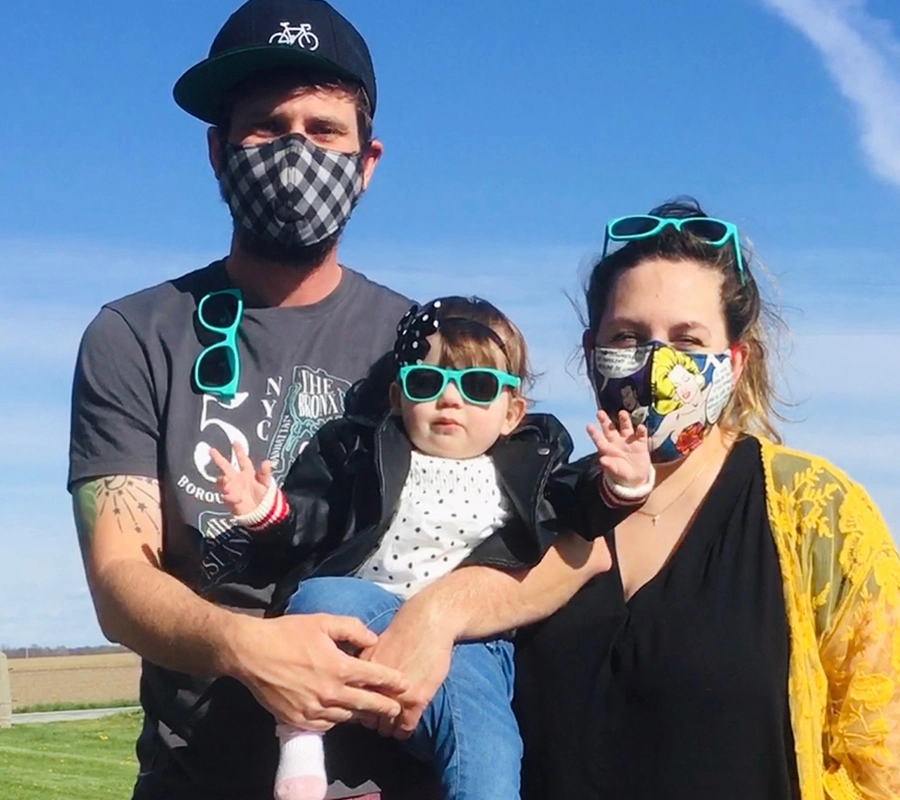When the pandemic hit and the Centers for Disease Control and Prevention (CDC) recommended wearing a homemade mask, many Americans were at a loss. Staying home as much as possible is key, but when you have to venture out, wearing a face covering can protect those around you in case you unknowingly have the disease and will help our communities slow the spread of the virus. Yet with a shortage of masks for healthcare providers, it’s important to reserve N95 and surgical masks for frontline healthcare workers who are caring for sick individuals. So how are we supposed to find or make a cloth mask?
That is when some of the most crafty Americans answered the call by dusting off the sewing machine. One such person is Brittany Root Ekstrom, who has made hundreds of masks for friends, as well as healthcare and essential workers.
A Call to Arms
Though Brittany currently works at a behavioral health practice, she has been sewing since she was a child and even graduated with a degree in fashion marketing from Parsons The New School for Design in NYC. So, when the CDC first suggested everyone wear cloth face coverings, her practice directors – knowing Brittany’s background – asked for her help to equip their staff.
“We were transitioning mostly to telehealth but we wanted to make sure we had masks available for those at the office and also for our potential return,” Brittany said. “So, I started by making two masks for each behavioral health clinician who sees patients on a regular basis and then building a supply for when everyone returns to work. I also knew friends and family needed face coverings, so I posted an offer to make them on social media. From there, I started making some for friends and then friends of friends.”
Now, Brittany is dedicating 6 to 10 hours a day to making masks and shipping them all across the country; from New York and D.C. to Indiana and even Florida. Her husband has not only supported her efforts, but he has even gotten involved by helping deliver, ship and even sewing masks himself.
“It’s really cool. I had no idea that people would want masks or care about them, but I’ve found people are overwhelmingly so appreciative to have them,” she said. “Many want masks and don’t know how to make them themselves, so I’m happy to be able to get them what they need.”
Perfecting Mask Design
The first batch of masks made were a simple, pleated style. But after receiving feedback from individuals using the masks and learning more about different designs and fit, Brittany decided to make adjustments that would ensure the highest quality masks. Her design features two layers of tightly woven quilters cotton and then a layer of flannel on the inside, totaling three cotton layers, to provide the best balance of breathability vs filtration. After hearing that elastic ties can be painful on the ears – especially for essential workers who may be wearing them for hours – she settled on using four ties rather than the elastic pieces around the ears.
Pro Tip:
It’s important to note that some people have a hard time wearing a cloth face covering at first, especially those with breathing issues already. Follow these steps to help yourself get used to wearing a cloth face covering:
- Think positive,
- Practice at home first
- Be creative
- Talk with your healthcare provider
To make the mask more fitted, she began making different sizes, including options for kids. Lastly, she added an aluminum wire nose piece that is rust resistant and can withstand numerous washings. “The nose piece was really important to me, because you are able to bend it around the nose so there are no gaps at the top. Going from mid nose to just below the chin at least is the biggest safety thoughts I had in mind,” she added.
Mastering Work/Life Balance
As orders increased, Brittany dug her industrial Juki sewing machine out of her parent’s basement and set up shop in her home office. Since then, her production has expanded into the kitchen as well. She uses her kitchen island for cutting fabric, then transfers the fabric to cubbies in the office to keep them organized. “I make them in batches of 20 or so at a time. I do a lot of cutting, then a lot of sewing, then a lot of pressing (ironing), etc. When the masks are done, I put them in baggies and include a 'care instruction' card that I created.”
Since early April, Brittany and her husband have worked tirelessly to get the orders filled while trying to juggle the daily needs of their 11-month-old daughter. “I'm thankful that my daughter is old enough that she's happy for longer stretches, playing independently in her playpen or sitting in her jumper beside me while I sew. My husband has also graciously taken on the majority of childcare responsibilities during this time. He keeps her happy while I sew and brings her to me every few hours for breastfeeding.”
Despite these challenges, Brittany is committed to her work, and glad that she has been able to offer her services in this time of need. “I haven’t worked in the [fashion] industry for a long time now, so it’s fun to sew again. I feel honored that I've been able to provide face coverings for the amazing mental health professionals that I work with, who are doing such important work all day long during this very trying time,” she said.
“I believe that if we all do our best to utilize our own skills and strengths, then it might make this difficult time a little more manageable. This is one skill I can share with others, and hopefully in some small way it is helping overcome some challenges individuals are facing during this horrible health crisis.”
Blog last updated: October 28, 2025





